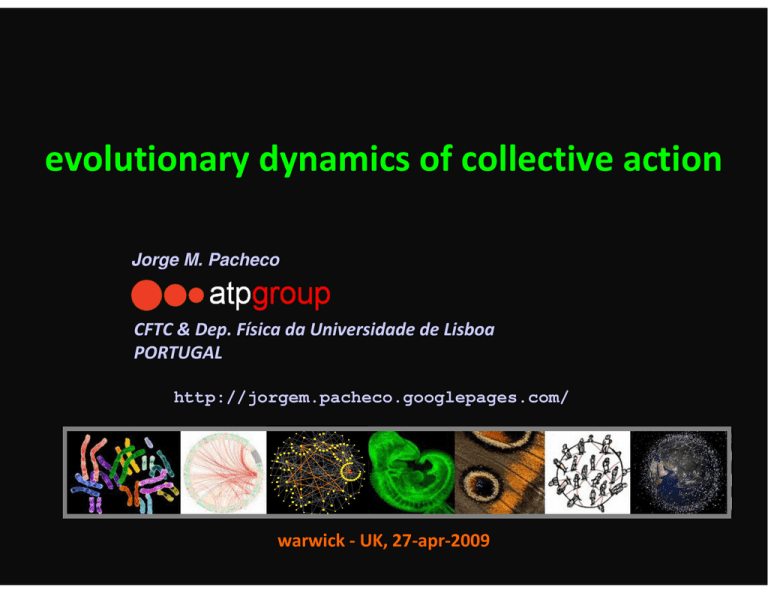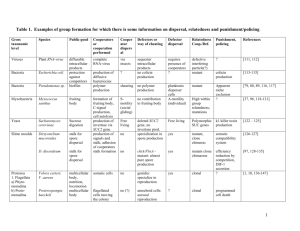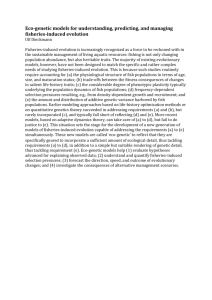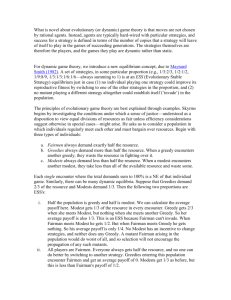evolutionary dynamics of collective action PORTUGAL warwick - UK, 27-apr-2009
advertisement

evolutionary dynamics of collective action Jorge M. Pacheco CFTC & Dep. Física da Universidade de Lisboa PORTUGAL http://jorgem.pacheco.googlepages.com/ warwick - UK, 27-apr-2009 the challenge of minimizing climate change saving the climate requires … cooperation ! the challenge of minimizing climate change Cooperation between individuals Cooperation between countries per capita CO2 emmisions france / sweden UK / japan USA x 2x 3x cooperation cooperation is on the basis of some of the major transitions in evolution [ Maynard-Smith & Szathmáry, The major transitions in evolution, OUP95 ] cooperation is essential for the evolution of reproductive entities genes cooperate to form cells cells cooperate to form multi-cellular organisms individuals cooperate to form groups and societies human culture is a cooperative process. [ Nowak, Evolutionary Dynamics: Exploring the Equations of Life, HUP06 ] how to formalize cooperation ? Donor Receiver Pays a cost c Receives a benefit b Why should we cooperate? if natural selection is based on competition, how can it lead to cooperation ? b>c QuickTime™ and a decompressor are needed to see this picture. cooperation & climate change Cooperation between individuals Cooperation between countries the cooperation we need to consider involves collective action public goods games (N-person games) france / sweden UK / japan USA per capita CO2 emissions x 2x 3x preserving the global climate is the biggest public goods game ever cooperation among humans - collective action to shelter & protect why do people contribute to public goods? cooperation among humans - collective action to shelter & protect cooperation among humans - collective action to hunt & nourish involves the coordinated action of many. . . why do people contribute to public goods? cooperation among humans - water sharing - tax paying and social welfare - stabilizing the Earth’s climate why do people contribute to public goods? cooperation among humans - open source projects … why do people contribute to public goods? a game experiment on climate change [ Milinski et al., PNAS 195 (2008) 2291 6 players, 10 rounds each player : 40 € contribution in each round : 0 (selfish), 2 (fair) or 4 (altruistic) cost for saving the planet : 120 € if Σ contributions ≥ 120 €, planet is saved and each gets away with money left if Σ contributions < 120 €, planet is saved with 10% prob., else all loose everything per capita CO2 emissions france / sweden x UK / japan USA 2x 3x strategy altruistic fair selfish a game experiment on climate change [ Milinski et al., PNAS 195 (2008) 2291 NASH equilibrium : each player contributes 2€ per round RESULTS : 50% of times planet was saved !!! 50% of times average contribution = 113 € < 120 € example of a failed attempt : did altruists feel they had contributed enough ? what was in the mind of the free riders ? a game experiment on climate change [ Milinski et al., PNAS 195 (2008) 2291 if : i. planet is saved with prob = 50% ii. planet is saved with prob = 90% 1 /10 reached 120€ 0 /10 reached 120€ still : i. <contribution> = 92€ ii. <contribution> = 73€ these experiments portray, once more, among other things, the bounded rationality of human participants. general mathematical tools Evolutionary Game Theory & the appropriate Game used by many scientists from diverse disciplines Specifically Evolution – REPLICATOR DYNAMICS Games – N-person prisoner’s dilemma ... Communities – HOMOGENEOUS ANSATZ : WELL-MIXED populations N-person Prisoner’s dilemma or Public Goods Game Donor Donor pays a cost c ? pays a cost c ? Group receives the benefit, invests it and shares the profits (N=4) Donor Donor pays a cost c ? pays a cost c ? “RATIONAL” GOAL : each maximizes own’s payoff ! public goods games N-person Prisoner’s Dilemma -2 types of players: Cooperators contribute an amount c (cost) to a public good Defectors do not contribute. The total contribution is multiplied by F and equally distributed among all individuals in the group (of size N ); then FcnC PD = N PC = PD − c (c=1) assuming someone contributes, it is always best to defect ! evolutionary game theory populations are infinite; there is a fraction xC of Cs & xD (= 1- xC) of Ds populations are well-mixed ; everybody is equally likely to interact with everybody else (mean field); fitness is obtained by averaging over all possible groups of size N; hence, ALL Cs have the same fitness & also ALL Ds have the same fitness (mean field) evolution replicator dynamics : strategies’ evolution follow the gradient of natural selection determined by relative fitness replicator equation r x&C = xC ( f C ( x ) − φ ) r x& D = xD ( f D ( x ) − φ ) those strategies whose fitness (reproductive success) exceeds the average fitness Φ of the population will increase in frequency; those that don’t will decline. N −1 k N −1−k f D (x) = ∑ PD (k) x (1− x) k k= 0 N −1 for N-person games (Public Goods Games), we have N −1 k N −1−k fC (x) = ∑ PC (k + 1) x (1− x) k k= 0 N −1 replicator equation xC + xD = 1 → x ≡ xC ⇒ xD = 1 − x → 1 equation ! x& = x(1 − x)[ f C ( x) − f D ( x)] ∆(x) equilibria of the replicator equation x = 0 ∨ x = 1 ∨ ∆( x) = 0 ∆(0) < 0 ⇒ x = 0 is stable ∆(1) > 0 ⇒ x = 1 is stable x ∗ ∈ ] 0,1 [ : ∆ ( x ∗ ) = 0 ; ∆′( x ∗ ) < 0 ⇒ stable ; else unstable evolutionary game theory payoff fitness social success group= population average fitness natural selection favors defection! natural selection leads to the tragedy of the commons! N-person dilemma : despite groups of cooperators being better-off than groups of defectors, individual “rational choice” leads to full defection 1 features of (human) collective action beyond conventional EGT coordination of collective action is often mandatory often the collective benefit is only achieved above a certain number of contributions. moreover, real populations are FINITE !!! N-person Coordination game N M M = coordination threshold Z • what happens when we require partial coordination before achieving collective action ? N-person Coordination game N-person Prisoner’s Dilemma with coordination requirements Cooperators contribute an amount c (cost) to a public good Defectors do not contribute. the total contribution (ck) is multiplied by F and equally distributed among all individuals in the group (of size N ), only if threshold number of Cs is exceeded !!! F PD = ck H (k − M ) N PC = PD − c cooperators now can pay a cost in vain N-person Coordination game N-person Prisoner’s Dilemma with coordination requirements Cooperators contribute an amount c (cost) to a public good Defectors do not contribute. the total contribution (ck) is multiplied by F and equally distributed among all individuals in the group (of size N ), only if threshold number of Cs is exceeded !!! F PD = ck H (k − M ) N Heaviside step function PC = PD − c cooperators now can pay a cost in vain N-person Coordination game tricky yet fun math λ∗ = R( M / N ) N-person Coordination game evolutionary dynamics in infinite pops fC - fD = ugly stuff, but we can still find its roots analytically for each value of F (multiplication factor), there’s a M* such that M<M* cooperators survive in the population M>M* x = fraction of cooperators evolution in finite populations yet, we know that populations are finite... How to formalize evolutionary dynamics in finite populations? group sampling is no longer binomial but hypergeometric . . . evolution in finite populations yet, we know that populations are finite... How to formalize evolutionary dynamics in finite populations? group sampling is no longer binomial but hypergeometric . . . Imagine the simplest form of social learning: Imitate a random individual with a probability that grows with the payoff difference. (NÆ∞ replicator equation ) evolution in finite populations at every “time”-step : - randomly choose 2 individuals (A & B) from the population ; - strategy of B replaces that of A with a prob given by p = [1+ e − β (PB −PA ) −1 ] - PA and PB are the payoffs of A and B ; - β controls how smoothly the probability changes from 0 to 1 : 1 5β 0 β << 1 : β0 Weak selection p PB − PA 0 0 Pacheco, Traulsen, Nowak, Phys Rev E (2006) evolution in finite populations at each time step we have a probability to increase and to decrease the number of cooperators, which is (Z=population size, j=number of cooperators) j Z− j 1 T = m β ( fC ( j )− f D ( j )) Z Z 1+ e ± j prob select C prob select D the gradient of selection becomes . . . g(k) ≡ T + (k)− T −(k) = β k Z− k tanh [ fC (k)− fD (k)] 2 Z Z take-over prob evolution in finite populations F<N F = mult. Factor = 8 N =Group Size = 10 M =Threshold = 5 k = total nº of cooperators Z = population size the size of the population can change the nature of the game conclusions (1) when a minimum number of cooperators is needed to perform a collective task, a rich dynamics with multiple equilibria emerges cooperation can be achieved if a minimum fraction of cooperators is present from the start cooperation can become stable whenever one takes into consideration that populations are finite, evolutionary dynamics can be profoundly affected. Pacheco, Santos, Souza, Skyrms, Proc. Royal Society B 276 1655 (2009) 2 well-mixed assumption is unrealistic in large populations modern societies are regulated by complex networks of exchange and cooperation individuals have different roles in the communities and may decide to cooperate depending on their social context diversity of roles new input (>1998) computer analysis of social, biological, chemical etc. interaction networks reveals existence of small-world effects and power-law distribution of connectivities. most real world networks are extremely heterogeneous a world of complex ties regular graphs, lattices... scale-free graphs Power-law heterogeneity + small-world effects k = degree = number of connections growth + preferential attachment Barabási & Albert, Science 1999 Barabási & Albert scale-free small-worlds start with m0 vertices; then : ( growth ) : add one vertex at a time and create m edges connecting this vertex to m other existing vertices; ( preferential attachment ): edge i->j ( j=1,...,m ) is chosen with prob. Pi = ki /Σi ki where ki is the connectivity of vertex i. preferential attachment is well-known . . . Economics rich get richer effect (Simon, 1955 ) History of Science cumulative advantage (Derek Price, 1965 ) ( the more you are cited the more likely you’ll be cited again ) Sociology Matthew effect (Merton 1968) ( if a Nobel laureate is the 1st author, all others are thought of as technicians ) introducing diversity Public Goods Games in structured populations k = degree = number of connections each individual plays k+1 public goods games the size of each public good is defined by the connections of each central individual introducing diversity graph heterogeneity leads individuals to engage in different numbers of PGGs with different group sizes homogeneous heterogeneous diversity (symmetry breaking) : a new route to cooperation under collective action ? cooperators will increase their fitness to the extent they succeed in maximizing their amount of cooperative interactions per generation. defectors will also increase their fitness by exploiting more cooperators per generation. WHO – defectors or cooperators – will be able to profit from diversity ? evolution on graphs k=2 k=3 k=4 k=1 k=4 k=2 Imitate a random neighbor with a probability that increases with the payoff difference. p = ( f y − f x )/ M F. C. Santos & J. M. Pacheco, Phys. Rev. Lett. 95 (2005) 098104. simulations on graphs setup: – Community = static graph – 50% of Ds and 50% of Cs. – evolve for 106 generations – run many simulations for one graph. – run many realizations for same class of graphs. results regular scale-free z = average degree = 4 z+1 = average group size = F/(z+1) population size = 1000 diversity in the number and size of public goods games enhances cooperation contributive schemes diversity creates new possibilities . . . unlimited resources limited resources egalitarian contributions Fixed cost per game contribution proportional to degree Fixed cost per individual equal contribution independent of degree real world situations will fall between (P. Rubin, Darwinian Politics, RUP, 2002) these 2 limits results fixed cost per game × fixed cost per individual cooperation dominates whenever individuals contribute a fixed amount. whenever the act of giving is more important than the amount given, cooperation prevails = F/(z+1) cooperation on the star(s) the most disadvantageous situation for a cooperator: star of size Z 1 hub (C) Z-1 leaves (Ds) every leaf has k-1 links (Ds) k the cooperator becomes advantageous whenever: F > 1− 2 / Z 1) cooperators can become advantageous in highly connected nodes!! 2) the critical multiplication factor F decreases with increasing Z and with decreasing k (k=Z -> regular network) cooperation on the star(s) cooperators can dominate if they invade the hubs... but, how can they get there? the most advantageous situation for a defector is: defectors are victims of their own success !! evolutionary dynamics of the marginally & centrally connected highly connected individuals are the ones who quickly become cooperators: k<z z<k<kmax/3 k>kmax/3 conclusions diversity paves the way for cooperators to explore their self-sustaining interaction nature and outperform defectors. the effect is enhanced whenever individuals contribute the same amount irrespective of the number of PGGs they engage (contributions depending on social context ) results may explain the emergence of cooperation when participation is compulsory and in the absence of mechanisms based on individual reputation or punishment. Francisco C. Santos, Marta D. Santos and Jorge M. Pacheco, Nature 454, 213-216 (2008).




